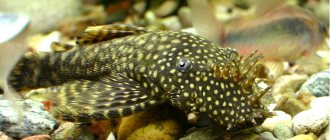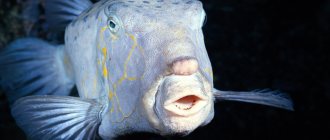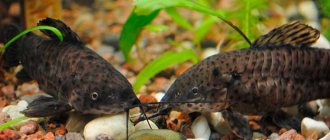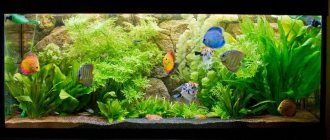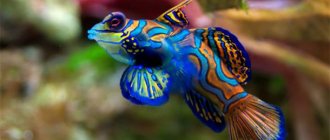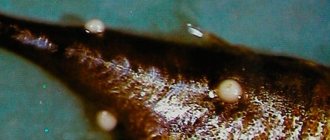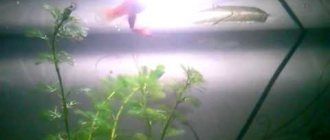Aquarium fish amaze with their diversity - there are small fish, and giants, bullies and civilians, and exotic options and those quite familiar to the eye - in a word, the number of names and characteristics can easily make a novice aquarist’s head spin.
Aquarium fish are usually called heterogeneous fish (mainly taxonomically), which are kept in aquariums for the purpose of decorating the interior: after all, almost all of them are distinguished by their bright colors and unusual body shapes.
Moreover, the first mentions of such fish breeding are found in China in 1500 BC.
Predatory aquarium fish
Aquarium fish can be very different - and the most difficult thing, of course, is with their predatory representatives. They are distinguished by their impressive size and aggressive character. It is popular to breed cichlids, piranhas, polypterus, discus and angelfish as predatory fish.
Polypterus
Angelfish
Before making a responsible decision about adding predators to an aquarium, you need to remember the difficulties associated with breeding them. Moreover, these difficulties are associated, first of all, not so much with meeting the needs for protein and living food, but with the need to maintain the proper level of quality (and this means purity) of water, taking into account all permissible hydrochemical indicators.
And keeping the aquarium properly clean can be the most difficult problem - after all, predators produce large amounts of organic waste. Given the need for a large aquarium volume for these fish, it will be necessary to equip them with high-performance systems related to water purification and monitoring. The aquarium must be correctly located and spacious enough. The water must be properly saturated with oxygen - and this will require special filters and aeration.
Cockerels
These labyrinth fish have a very beautiful veiled tail and fins. They can be of a wide variety of colors. When keeping them, the recommended water temperature is 22-24 degrees. Well compatible with all peaceful fish. According to reviews from owners, males can quarrel with each other, as well as males and females during the spawning period. There is no need to combine swordtails with barbs and cichlids.
This work presents an abstract with elements of research. The author uses personal experience in his work.
Diseases of aquarium fish
As in the animal world, in the world of aquarium inhabitants there are hundreds, if not thousands, of types of diseases and even more reasons for their occurrence. But the main and main reason for almost any disease of aquarium fish is only one - unsuitable or even simply poor living conditions.
Such global reasons affecting fish health include:
- neglect of the aquarium (stagnant or polluted water and a lot of organic waste);
- unsuitable composition of water for fish, its poor quality, imbalance;
- improper arrangement of the aquarium (bright lighting, low temperature, overcrowding);
- failure to take into account the characteristics of various fish species - mainly their behavior;
- unsuitable food or incorrectly formulated diet, overfeeding;
- improper compliance with quarantine rules and regulations for new fish (from three to eight weeks).
All these external factors contribute to the negative manifestation of the well-being of aquarium fish, which leads, first of all, to a decrease in the level of their immunity. As a consequence, in this case, the risk of infection of the inhabitants of the aquarium with a variety of bacteria and pathogenic microorganisms increases.
Columnaria is a fish disease
Fish diseases are usually divided into several types:
- contagious – caused by a fungus or infection;
- not contagious - they are mainly caused by unfavorable environmental conditions.
In general, several more forms of diseases of aquarium inhabitants can be distinguished depending on the type of manifestation: these can be diseases that manifest themselves by external signs (such manifestations can be treated without problems if detected in a timely manner), and internal diseases that are very difficult to diagnose. As a rule, in this case, you need to pay attention to the behavior of the pets (loss of appetite, change in color or a sudden change in movement technique).
Naturally, to combat fish diseases and successfully treat them, a variety of medications are usually used - everything is the same as in humans. But in order to accurately determine which medications, in what doses and in what order you may need the help of a specialist, it is best to contact a special clinic. Of course, you can diagnose it yourself, but you need to understand that it will be quite difficult for a novice aquarist to do this - after all, many diseases have very similar symptoms.
Sociable swordtails
They often join schools of guppies and mollies, thereby complementing the composition of the aquarium. Male swordtails have a distinctive “sword” that acts as their tail. This unique trait is eye-catching and makes them a desirable fish for any aquarist.
Swordtails originate from Central America, namely Mexico and Guatemala. Like most species from these regions, swordtails easily adapt to any environment. They feel especially good when surrounded by small and peaceful fish.
Treatment of aquarium fish
Before carrying out any treatment or administering any medicine, you must clearly make sure that the disease has been diagnosed correctly, and the cause of the fish’s illness has been correctly identified. Most often, the cause of the disease can be elementary stress associated with transportation or changes in water quality. In this case, it is necessary to test the water and take all measures to improve its performance.
And before adding the medicinal drug, it is advisable to remove any activated carbon from the filter - otherwise the medicine simply will not work. And don't forget to read the instructions for the drug!
Having determined the cause and eliminated all the obvious problems with the disease (water quality or new inhabitants), it is necessary to determine what the fish is sick with, observing the expressed symptoms, and then carry out treatment.
You need to understand that the inhabitants of an aquarium do not get sick just like that - and the main negative impetus for this is almost always inappropriate living conditions. And it is best to start any treatment with finding the root cause of the problem - and eliminating it. And then a decision is made on the correct treatment mechanism.
Journey through the underwater world
The world of wildlife around us is amazing and diverse. And, naturally, many have a desire to learn more about him. Of course, the best way to get to know the inhabitants of the continents, fresh and sea waters is travel.
An aquarium helps us make such a journey. In winter and summer, spring and autumn, we see part of the underwater world, living a special, unique life. Here you can observe an amazing variety of colors and shapes of animals, their different behavior, amazing adaptability to certain living conditions.
Aquarium fish compatibility
The compatibility of fish in an aquarium system is a question that worries not only novice aquarists. After all, solving the problem of populating an aquarium automatically leads to the question of the livability of the fish, which can literally serve as the cause of life or death for all its inhabitants.
The topic of compatibility is quite extensive, and is controversial even for experienced aquarium fish breeders. Moreover, it is decided quite individually in each specific case - which is why compatibility raises a huge number of questions and disagreements.
Compatibility table
Compatibility table for aquarium fish
Regarding the compatibility of the inhabitants of the aquarium, there are several main points that require careful consideration when addressing this issue:
In order to ensure a safe and comfortable coexistence for the fish, it is necessary, first of all, not to try to combine marine and freshwater inhabitants. After all, these types of fish have diametrically different needs for water - and it is unrealistic to combine them in one aquarium.
However, the most important rule is that for a full life in an aquarium, its inhabitants need to create conditions that are as close as possible to natural ones. Those. To fill the aquarium, it is necessary to clarify the limits of acceptable values for temperature, acidity and water hardness for those fish that will be selected as residents of the aquarium.
Neon tetra
Neon tetras are small, high-energy aquarium fish. Their homeland is in South America. Aquarists love them due to their bright colors and interesting schooling habits. Neon tetras are ideal for creating a lively and natural aquarium.
Neon tetras are considered fairly easy to care for and can adapt to many types of conditions. Given its small size, the tetra will feel great even in a cramped aquarium.
Neon tetras are ideal for creating a lively and natural aquarium.
Care and maintenance
Any aquarist knows very well the basic and main rule of fish breeding: and this is a decent state of water.
First of all, it must be settled - and the time for settling is mainly determined by the type of fish. For some fish, just a day is enough, while others will require much more. This is due to the fact that during the day the chlorine contained in the water may not have time to evaporate completely - and the water will acquire optimal values only after a few days.
A good life hack from experienced breeders: you don’t have to wait several days for the water to settle, but simply warm it up to a temperature of about 70 degrees - and then just let it cool. This won’t take much time, but it will help remove excess oxygen, which is unnecessary for the fish.
It must be remembered that you should not change the water too often after the cleaning process. You just need to add clean water in small portions - but it is recommended to do this only after thoroughly cleaning the bottom of the aquarium. It is advisable to do this once a week - and the optimal amount of fresh water that can be used to renew the aquarium is a third (no more!). And do not forget that for some tropical fish, changing water can be severely stressful - therefore, for such species you need to reduce the amount of refreshed water to 1/5 of the total volume.
Don't panic if the water suddenly becomes cloudy - sometimes this can be caused by food residues. In this case, you just need to clean the water and remove dry food from the fish’s diet. The best option is to simply evacuate the fish temporarily; and if the water does not reach clean parameters, then simply clean the aquarium completely.
If you are just planning to stock a new aquarium with fish, then you need to remember that it needs to be washed first. To do this, you need to change the water every few days for a week - and then you can fill the aquarium with soil and plant plants. You should not use fine sand as soil - it can affect the metabolic processes in the aquarium.
After this, the aquarium should remain undisturbed for another week to allow algae and plants to take root. And after all these procedures, you can move in residents - but always taking into account their preferences, character and characteristics of the content. You should be especially careful if there are already inhabitants in the aquarium.
And an important point - any aquarium must be equipped with an aerator. Moreover, the air supply must be provided for at least eight hours throughout the day.
Amazing facts
Do you know that…
- If you have high blood pressure and are looking for a way to get rid of stress, get yourself an aquarium with ornamental fish. The owners of Swiss pet stores came to this seemingly paradoxical conclusion almost earlier than doctors, seeing how this product is increasingly displacing parrots, canaries and other living creatures from the shelves. Scientists have found that watching fish swim in an aquarium lowers blood pressure.
- The smallest fish in the world is the pygmy goby, living in rivers and lakes in the Philippine Islands. Its body length is only 1 cm. This is the smallest animal of all vertebrates. He is extremely prolific.
- And the smallest of the sea fish is the Caspian goby Berg, its length very rarely reaches 2 cm.
- The largest existing fish is the whale shark. This giant's body length can reach 15-20 m, and sometimes weighs 10 tons. More than 60 million years ago there lived a carcharon shark, its body length reached more than 30 m.
- Of the freshwater fish, the largest fish is the arapaima, which lives in the rivers of South America. The length of its body reaches 4.6 m, and the weight of some specimens approaches 200 kg.
- Beluga fish can live up to a hundred years or more. It spawns in rivers and lives in the sea.
- The most prolific fish is the moon, it lays up to 300 million eggs. The size of each egg of this fish is about 1 mm. Putting them side by side, we get a chain 300 km long, which is impressive.
- For spear fish, breaking through the casing is a piece of cake. It is no coincidence that in the old days, when ships were made of wood, they were often wrecked by ramming fish, which now belongs to the category of relicts.
And that's not all the amazing facts from the life of fish!
What to feed
The issue of fish diet, feeding frequency and amount of food can be reduced to the simplest recommendations:
- adult fish need to be fed once a day - and the food should be destroyed within a little less than an hour;
- The ideal option would be to feed twice a day - and the food should be eaten within half an hour;
- If we are talking about fry, then they need to be fed quite often - depending on age and size. Moreover, sometimes a constant supply of food may be required.
But any fish can easily do without any food for several weeks without any problems. Moreover, in the old aquarium there will definitely be snack options for her.
And this option will be preferable than, if necessary, leaving the aquarium to a non-specialist, who can create difficulties by overfeeding the fish (and this means rottenness of the water and death of the inhabitants of the aquarium).
And, in order not to leave the aquarium in the hands of strangers, modern technology can offer several ways out of the situation:
- special foods that soften over a long period of time;
- special automatic feeders, in which, if desired, the feeding period and the amount of food dispensed can be set.
High fin shark catfish
The high-fin shark catfish is native to Southeast Asia. What is noteworthy is that this fish has nothing to do with sharks, although the similarity is striking.
In nature, shark catfish reach large sizes, but aquarium species, as a rule, do not reach a length of 50 centimeters. The high-fin shark catfish has a rather calm character, but this is only the case while the fish is well-fed. And in a hungry state, they attack everything that can fit into their mouths. Those fish that cannot fit in the mouth do not evoke any emotions in shark catfish. They will never try to tear a piece off a victim, as real sharks do.
The shark catfish is an aquarium resident that has nothing in common with sharks.
High-finned shark catfish can be kept with motoro rays and red parrots.
Spotted armored pike
This is another predator with a spectacular appearance from North America. The size of an adult in the wild is 1.5 meters.
Today, spotted armored pike are bred in Malaysia and China. These strange fish can be purchased at large pet stores.
Spotted armored pike are not a common specimen in home aquariums.
Guppy
There is probably not an aquarist in the world who has never kept these simple, but cute and unique in their endurance aquarium fish. Apparently, their endurance led to such amazing popularity. Guppies can adapt to a wide range of water conditions, survive in soft, hard and salt water, and are also prepared to overcome the difficulties with regular aquarium care that beginners always have.
But guppies are not only hardy - they are extremely diverse. Currently, a huge variety of colors of these fish has been obtained in all colors of the rainbow, as well as white, silver and black. Although the males usually abound in flowers, the females mostly remain a natural gray-beige-green color. Males are also distinguished by the variety of shapes of their caudal fins.
Guppies can be kept, as was said, in water of any hardness at a temperature from 10 to 29 ° C. The fish feed on any offered food of a suitable size.
Guppies are also famous for their ability to reproduce abundantly, for which they even received the nickname “millionaire fish.” The eggs of these fish develop in the abdomen of the female, and the fry are born alive and highly developed, capable of feeding on their own. Therefore, guppies are viviparous fish. Buy two males and a female, and in six months the population in your aquarium will increase several times.
Goldfish
There are several types of goldfish: common goldfish, veiltail, telescope, red cap, fantail and others. Most of them are extremely famous and popular. Unfortunately, there is a very common myth that goldfish can be kept in a small round aquarium. However, goldfish of all types are very large fish, can grow up to 40 cm in length, so a fairly spacious aquarium is required to keep them.
In addition, these are “dirty” fish - they eat a lot, litter a lot, constantly dig in the ground, digging up plants and moving decorations. But if you keep goldfish correctly, they will live with you for many years, delighting you with their beauty and interesting behavior.
Mollies
Mollies are small black aquarium fish, also known, popular and widespread throughout the world, like guppies and neons. They are only slightly larger than guppies and slightly less hardy, although they are also adaptable to different water conditions. However, to keep them you need a larger aquarium - molly grows up to 7.5 - 12 cm.
Mollies are the world's most famous aquarium fish, with an almost perfect solid black color (sometimes there may be lighter spots on the body).
To keep mollies you need an aquarium of at least 75 liters; you can feed them with any food and plant foods. They reproduce almost as easily as guppies.
Danio rerio
Danio rerio is another extremely hardy varium fish, ideal for the beginning aquarist. Danio rerio were previously known only as ordinary striped fish or pink albino fish with a striped body.
However, thanks to geneticists, you can now find very bright and attractive danio rerio glofish (glowing neon fish) on sale in several colors: green, yellow, blue, purple, red, etc. Colored danios are just as hardy and reproduce successfully as their natural counterparts ancestors of zebrafish and are becoming very popular.
An aquarium of 35 liters or more is required for maintenance. Zebrafish must be kept in a group, otherwise the fish will experience constant stress. These are very fussy and active fish; they will eat any food offered.
By the way, although zebrafish lay eggs, they reproduce very easily, and the fry are very hardy. Therefore, it is worth starting attempts to reproduce egg-laying aquarium fish with this species.
